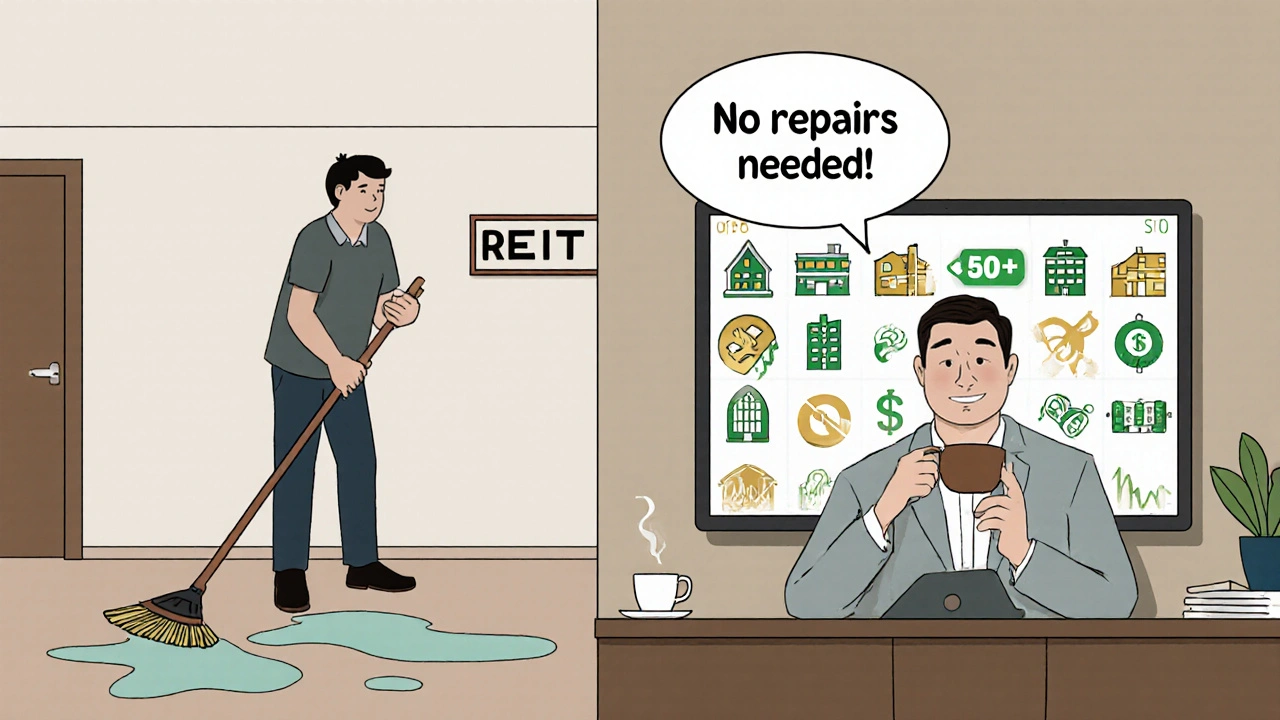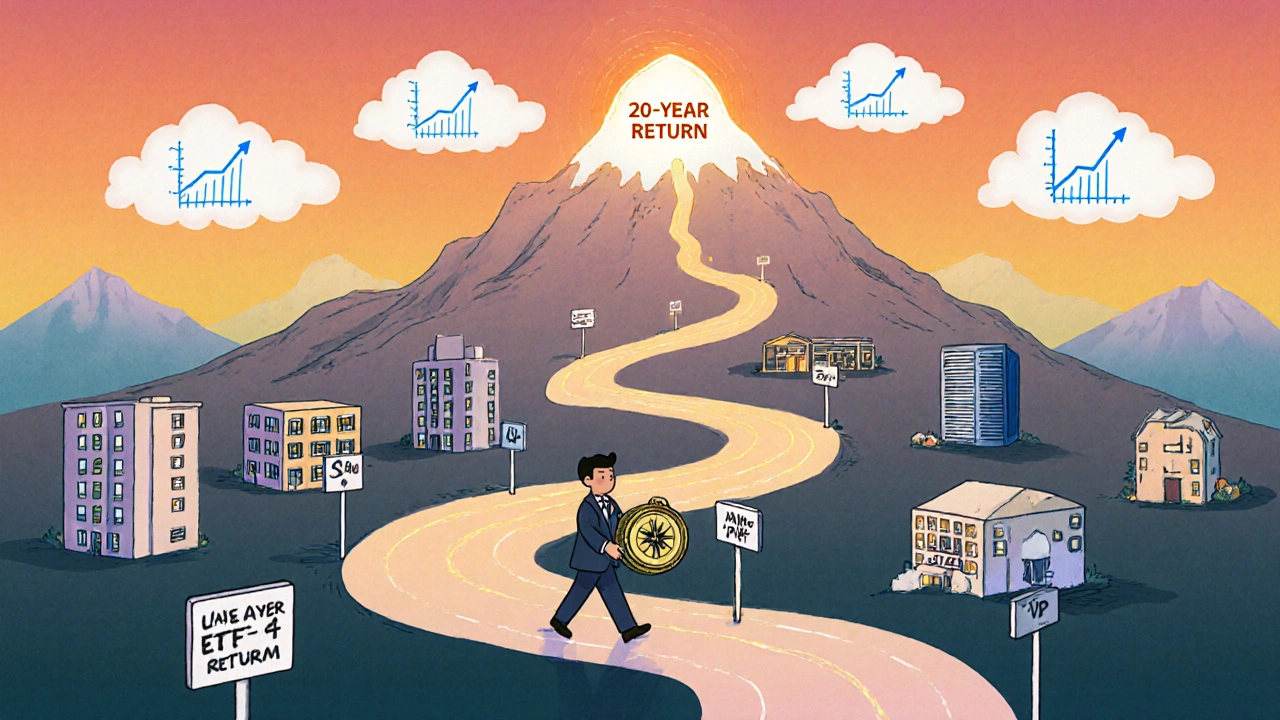REIT ETF Portfolio Calculator
Calculate how much of your portfolio should go to REIT ETFs based on your investment goals, risk tolerance, and tax situation.
Results
RecommendedETF Comparison
| ETF | Expense Ratio | Dividend Yield | Minimum Investment |
|---|---|---|---|
| Vanguard VNQ | 0.13% | 4.2% | $0 (fractional shares available) |
| Schwab SCHH | 0.07% | 4.5% | $0 (fractional shares available) |
| iShares IYR | 0.43% | 3.8% | $0 (fractional shares available) |
Want to own real estate but don’t want to deal with tenants, repairs, or mortgage payments? You’re not alone. Millions of people are using REIT ETFs and REIT funds to get exposure to apartments, warehouses, offices, and data centers-without ever stepping foot in a building. And it’s easier than you think.
Back in 1960, Congress created Real Estate Investment Trusts (REITs) so regular people could invest in real estate like they invest in stocks. Before that, owning rental properties meant big money, lots of time, and serious risk. Now, you can buy a single share of a REIT ETF and own pieces of hundreds of properties across the country-and even the world.
What Exactly Is a REIT?
A REIT is a company that owns and manages income-producing properties. That could be apartment buildings in Atlanta, warehouses in Ohio, shopping centers in Texas, or even cell towers in rural areas. These companies collect rent, pay expenses, and then give most of the leftover cash to shareholders as dividends.
By law, REITs must pay out at least 90% of their taxable income as dividends. That’s why many REITs offer yields between 4% and 7%-sometimes even higher for niche sectors like data centers or cell towers. Compare that to the average S&P 500 stock, which pays around 1.5%. And unlike stocks, REITs are tied to real assets that tend to hold their value during inflation. When rents go up, so do REIT payouts.
There are over 225 publicly traded REITs in the U.S., with a total market value of $1.4 trillion. You can buy shares of any of them through a regular brokerage account. But here’s the catch: owning one REIT means you’re betting on one type of property in one market. If you buy a retail REIT and online shopping keeps killing malls, your dividends could drop fast.
Why REIT ETFs Are the Smart Choice for Most Investors
That’s where REIT ETFs come in. An ETF (Exchange-Traded Fund) is a basket of stocks bundled together and traded like a single stock. A real estate ETF holds dozens-or even hundreds-of different REITs. So instead of owning just one apartment company, you own pieces of apartment REITs, warehouse REITs, office REITs, medical properties, and more.
The most popular one is Vanguard’s VNQ. As of 2023, it holds over 150 REITs across every major property type. Its expense ratio? Just 0.13%. That means for every $10,000 you invest, you pay $13 a year in fees. Compare that to some actively managed REIT mutual funds that charge 1.5% or more-$150 a year on the same amount.
Other top ETFs include Schwab’s SCHH (0.07% fee) and iShares’ IYR (0.43% fee). These aren’t just cheap-they’re liquid. You can buy or sell shares anytime the market is open. No waiting weeks for a redemption like with private REITs.
Private REITs? Avoid them. They’re sold through brokers, not exchanges. They charge upfront fees of 3-5%, lock your money in for 5-10 years, and often don’t let you sell even if you need cash. A 2023 survey found private REIT investors had a 2.8/5 star rating on Trustpilot-with complaints about lack of transparency and frozen assets. Public REIT ETFs? 4.6/5 stars.
How Diversified Are REIT ETFs Really?
Yes, REIT ETFs spread your risk across many properties. But don’t assume they’re perfectly balanced. In VNQ, the top 10 holdings make up nearly half the fund. American Tower (cell towers), Prologis (warehouses), and Equinix (data centers) alone account for over 24% of the fund.
That’s not a flaw-it’s reality. These are the biggest, most profitable real estate companies in the U.S. But it does mean your ETF isn’t as diversified as it seems. If data centers crash, you’ll feel it hard. That’s why some investors mix ETFs with a few individual REITs to target specific trends.
For example, if you believe AI will keep driving demand for server space, you might add Digital Realty (DLR) to your portfolio. If you think housing shortages will keep rents rising, you might add AvalonBay (AVB). But you’re still better off with the ETF as your core holding and a couple of individual REITs as satellites.

Dividends: High Yield, But Taxed Like Salary
REIT dividends are great-but they’re not treated like regular stock dividends. Most stock dividends are taxed at the lower qualified dividend rate (0-20%). REIT dividends? They’re taxed as ordinary income, just like your paycheck. That means if you’re in the 22% tax bracket, you pay 22% on your REIT dividends.
This is a big reason why many investors hold REITs in tax-advantaged accounts like IRAs or 401(k)s. That way, you avoid paying taxes on dividends until you withdraw-and sometimes not at all if it’s a Roth account.
And yes, REITs are sensitive to interest rates. When the Fed raises rates, borrowing costs go up. REITs borrow money to buy property, so higher rates squeeze profits. In 2023, as rates climbed, REITs underperformed the S&P 500 by over 7 percentage points. But over the long term, real estate has outperformed the broader market. The S&P U.S. REIT Index returned 10.2% annually over the past 20 years-slightly better than the S&P 500’s 9.8%.
Who Should Invest in REIT ETFs?
REIT ETFs are perfect for:
- Beginners who want exposure to real estate without research overload
- Investors seeking steady income with less hassle than rental properties
- People building long-term portfolios who want inflation protection
- Those who already own stocks and bonds and want to add a tangible asset class
You don’t need a lot to start. Most brokerages like Fidelity, Schwab, and Robinhood let you buy fractional shares. So if VNQ is trading at $85 a share, you can buy $50 worth-and still get your share of the dividends.
On the other hand, if you’re a hands-on investor who loves digging into financial statements, tracking occupancy rates, and analyzing local housing markets, individual REITs might be more satisfying. But that takes time. Experienced investors say they spend 5-10 hours a month monitoring each REIT they own.

What’s Changing in 2025?
The REIT ETF space is evolving fast. In 2023, the SEC approved the first actively managed real estate ETFs focused on ESG (Environmental, Social, Governance) criteria. Now you can invest in REITs that prioritize energy-efficient buildings or fair labor practices.
Vanguard just lowered VNQ’s fee from 0.14% to 0.13%. Schwab and iShares are likely to follow. Expect more fee cuts-and more consolidation. J.P. Morgan predicts the number of real estate ETFs will drop from 64 to 40 by 2026. The small, niche funds won’t survive.
At the same time, sector-specific ETFs are booming. Funds like DCD (data centers) and VPN (digital infrastructure) are drawing attention. If you believe cloud computing and AI will keep growing, these could be smart additions to your portfolio.
How to Get Started
Here’s how to start investing in REIT ETFs in 2025:
- Open a brokerage account (Fidelity, Schwab, or Robinhood work well).
- Decide how much you want to allocate to real estate. Most advisors suggest 5-15% of your portfolio.
- Buy a broad-market ETF like VNQ or SCHH. SCHH is cheaper; VNQ has more history and slightly higher liquidity.
- Set up automatic reinvestment of dividends to compound your returns.
- Hold it for the long term. REIT ETFs aren’t for day trading. They’re for steady income and growth.
Don’t chase high yields. A REIT paying 10% might be in trouble. Look for consistent payouts, low fees, and strong balance sheets. Check the fund’s top holdings. If it’s 80% in data centers and 20% in malls, you’re not diversified-you’re betting on one trend.
Final Thought: REIT ETFs Are the Quiet Winner
Most people don’t talk about REIT ETFs the way they talk about crypto or tech stocks. But over the last 20 years, they’ve delivered better returns than the S&P 500-with less effort. You don’t need to be a real estate expert. You don’t need to fix leaky roofs. You just need to buy a low-cost ETF, hold it, and let rent checks roll in.
Real estate isn’t going away. People will always need places to live, work, and store things. And REIT ETFs give you a simple, cheap, and liquid way to own a piece of that.
Are REIT ETFs better than buying individual REITs?
For most people, yes. REIT ETFs offer instant diversification across dozens of property types and companies, reducing the risk of one bad tenant or market crash wiping out your investment. Individual REITs can offer higher returns if you pick a winner, but they require deep research, ongoing monitoring, and carry more risk. If you’re not willing to spend hours analyzing financial reports, an ETF is the smarter move.
Do REIT ETFs pay dividends monthly or quarterly?
Most REIT ETFs pay dividends quarterly. Some, like VNQ, distribute income every three months. A few specialized ETFs may pay monthly, but these are rare and often come with higher fees or less diversification. Always check the fund’s distribution schedule before investing.
Are REIT ETFs safe during a recession?
It depends on the property types. Apartment REITs tend to hold up better in recessions-people still need a place to live. Retail and office REITs suffer more when unemployment rises. Broad REIT ETFs like VNQ spread that risk, so they’re generally more stable than individual REITs. Historically, real estate has recovered faster than stocks after downturns, making ETFs a solid long-term hedge.
Can I lose money investing in REIT ETFs?
Yes. REIT ETFs can drop in value, especially when interest rates rise or the economy slows. In 2022 and 2023, many REIT ETFs fell 15-25% as the Fed raised rates. But if you hold them long-term and reinvest dividends, you’ve historically recovered and grown your investment. Don’t panic-sell during downturns.
What’s the difference between a REIT mutual fund and a REIT ETF?
REIT mutual funds are bought and sold at the end of the trading day at a fixed price, while ETFs trade like stocks throughout the day. ETFs are usually cheaper, more tax-efficient, and more liquid. Most REIT mutual funds have higher expense ratios and minimum investments. Unless you’re using a specific mutual fund with unique features, ETFs are the better choice for most investors.
Should I buy REIT ETFs in a taxable or tax-advantaged account?
Tax-advantaged accounts like IRAs or 401(k)s are ideal because REIT dividends are taxed as ordinary income. Holding them in a taxable account means you pay higher taxes each year on dividends. If you’re in a high tax bracket, put your REIT ETFs in an IRA. If you have a Roth IRA, you can withdraw dividends tax-free in retirement.

Comments (3)
Laura W
Bro, I dumped my entire emergency fund into VNQ last year and honestly? Best decision ever. Got 6.2% yield, no landlord nightmares, and my portfolio’s been chillin’ while my friends are stressing over leaky basements. Even my cat seems happier now - probably because I’m not screaming at plumbing bills anymore.
Also, fractional shares? Game changer. Bought $20 worth of SCHH on Robinhood and now I feel like a real investor. Who needs a mansion when you own a slice of a data center in Virginia?
Graeme C
Let me be unequivocally clear: REIT ETFs are not an investment - they are a structural arbitrage opportunity disguised as passive income. The 90% dividend payout requirement is a regulatory loophole that effectively transforms corporate earnings into tax-advantaged cash flow streams - and the market has priced this inefficiency poorly.
While your average retail investor latches onto ‘diversification’ like a security blanket, the reality is that 80% of REIT ETF exposure is concentrated in five sectors: data centers, cell towers, industrial logistics, healthcare, and multifamily. These are not ‘real estate’ - they are infrastructure plays with rent rolls.
And yes, interest rates hurt - but only until inflation stabilizes. The Fed’s terminal rate will be lower than markets expect. When that happens, REITs will re-rate faster than meme stocks crash. Buy the dip. Hold forever. Ignore the noise.
Also, SCHH is objectively superior to VNQ. Lower fee, same exposure. Stop overpaying for brand recognition.
Astha Mishra
It is truly fascinating how the modern investor has come to view real estate not as a physical, tangible space where life unfolds - homes, workplaces, communities - but as a financial instrument, a ticker symbol, a line on a balance sheet. We have detached ourselves from the soil, from the bricks, from the human stories behind each lease agreement.
Yet, in this detachment, there is a quiet wisdom. To own a piece of a warehouse that holds medicine for a child, or a cell tower that connects a grandmother to her grandchild across continents - that is not just investment. That is participation in the architecture of human need.
I wonder, though, if we are trading depth for convenience. The amateur who buys VNQ without knowing the difference between an industrial REIT and a healthcare REIT is like someone who eats a gourmet meal without tasting it. But perhaps, for many, this is the only way to access the table at all.
And so, I do not judge. I only observe. The world moves fast. We simplify to survive. Let the ETFs be the bridge - but may we never forget the land beneath them.
Also, please, for the love of all that is holy, do not hold REITs in a taxable account unless you enjoy paying 30% tax on rent money. I learned this the hard way after my 2022 tax bill nearly made me cry into my chai.